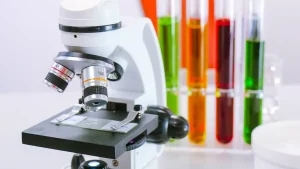
Graphite components encounter significant challenges in demanding environments. By applying TaC coating, their durability and thermal stability are significantly enhanced. This coating creates a protective barrier that withstands wear, chemical corrosion, and intense heat. TaC coating is a reliable solution to prolong the lifespan of graphite parts, minimize maintenance requirements, and boost overall performance.
Understanding TaC coating
Composition and properties of TaC coating
TaC coating, or tantalum carbide coating, is a material known for its exceptional hardness and thermal stability. It consists of tantalum and carbon atoms arranged in a crystalline structure. This unique composition gives it a high melting point of over 3,800°C, making it one of the most heat-resistant materials available.
You’ll find that TaC coating is also incredibly durable. Its hardness ranks close to diamond on the Mohs scale, which means it can resist wear and abrasion effectively. Additionally, it has excellent chemical inertness. This property allows it to withstand exposure to harsh chemicals without degrading.
Another key feature is its low thermal expansion. When exposed to extreme heat, it maintains its shape and integrity. This makes it ideal for applications where stability under high temperatures is critical.
Why TaC coating is ideal for graphite components
Graphite components often face challenges in demanding environments. TaC coating provides a solution by acting as a protective shield. It prevents wear and tear caused by friction and abrasion. This ensures your graphite parts last longer, even in harsh conditions.
The coating also protects graphite from chemical corrosion. In industries where components come into contact with reactive substances, this resistance is crucial. It keeps the graphite intact and functional.
High temperatures can degrade uncoated graphite. TaC coating solves this problem by offering thermal stability. It allows graphite components to perform reliably in extreme heat without losing their structural integrity.
By combining these properties, TaC coating enhances the performance and lifespan of graphite components. It ensures they remain efficient and durable, even in the most challenging environments.
Challenges of uncoated graphite components
Wear and abrasion in industrial environments
Uncoated graphite components often struggle in industrial settings. These environments expose them to constant friction and abrasive forces. Over time, this wear reduces their efficiency and shortens their lifespan.
For example, in manufacturing processes, moving parts made of graphite rub against other surfaces. This friction gradually erodes the material. Without a protective layer, the graphite becomes thinner and weaker.
Tip: If your graphite components face heavy wear, consider adding a protective coating like TaC. It can significantly reduce material loss and extend the life of your parts.
Vulnerability to chemical corrosion
Graphite is naturally reactive to certain chemicals. When exposed to corrosive substances, it begins to degrade. This reaction weakens the structure and compromises its performance.
Industries like chemical processing or metallurgy often use graphite components in harsh environments. Without protection, these parts can fail prematurely. For instance, acids or alkalis can eat away at the surface, leaving the graphite brittle and unreliable.
Note: Protecting graphite from chemical corrosion is essential for maintaining its functionality in demanding applications.
Thermal degradation in high-temperature conditions
High temperatures pose another challenge for uncoated graphite. Prolonged exposure to extreme heat causes the material to oxidize. This oxidation leads to surface damage and structural instability.
In applications like furnaces or aerospace, where temperatures soar, uncoated graphite cannot maintain its integrity. It may crack, warp, or lose its shape entirely.
Emoji Insight: 🔥 Heat resistance is crucial for graphite components. A coating like TaC can shield them from thermal damage and ensure reliable performance.
By addressing these challenges, you can improve the durability and efficiency of your graphite components. Coatings like TaC offer a practical solution to overcome these issues.
Benefits of TaC coating for graphite components
Enhanced resistance to wear and abrasion
TaC coating significantly improves the durability of graphite components. Its exceptional hardness acts as a shield against wear caused by friction and abrasive forces. When your graphite parts operate in high-friction environments, this coating minimizes material loss. It ensures that the components maintain their structural integrity over time.
For example, in manufacturing processes, moving parts often experience constant rubbing. Without protection, this friction can erode the surface. TaC coating prevents this by forming a tough, wear-resistant layer. As a result, your components last longer and perform more efficiently.
Tip: If your equipment faces heavy wear, applying TaC coating can save you from frequent replacements.
Protection against chemical and thermal damage
Graphite components often encounter harsh chemicals and extreme heat. TaC coating provides a robust barrier that resists chemical corrosion. It prevents reactive substances from degrading the graphite. This protection is essential in industries like chemical processing, where exposure to acids or alkalis is common.
The coating also excels in high-temperature environments. It withstands intense heat without breaking down. This thermal stability ensures that your graphite parts remain functional, even in demanding conditions.
Emoji Insight: 🛡️ TaC coating acts like armor, protecting your components from chemical and thermal threats.
Improved performance in extreme conditions
TaC coating enhances the overall performance of graphite components. It allows them to operate reliably in extreme environments. Whether exposed to high friction, corrosive chemicals, or intense heat, the coating ensures consistent functionality.
This reliability reduces downtime and maintenance needs. Your equipment runs smoothly for longer periods, improving productivity. By investing in TaC coating, you can optimize the performance of your graphite parts and extend their service life.
Note: Reliable components mean fewer interruptions and better efficiency for your operations.
Application process of TaC coating
Techniques for applying TaC coating
Applying TaC coating involves advanced techniques to ensure a uniform and durable layer. One common method is chemical vapor deposition (CVD). In this process, you expose the graphite component to a mixture of tantalum and carbon-containing gases at high temperatures. These gases react and form a thin, even layer of TaC on the surface.
Another technique is physical vapor deposition (PVD). This method uses a vacuum chamber where tantalum is vaporized and deposited onto the graphite. PVD creates a strong bond between the coating and the substrate, enhancing durability.
You might also encounter plasma spraying. This technique involves spraying molten TaC particles onto the graphite surface. It’s ideal for applications requiring thicker coatings. Each method has its advantages, and the choice depends on your specific needs.
Factors affecting coating quality and durability
Several factors influence the quality and lifespan of TaC coating. The surface preparation of the graphite is critical. A clean, smooth surface ensures better adhesion. Temperature control during the application process also plays a key role. Too much heat can damage the graphite, while insufficient heat may result in poor bonding.
The thickness of the coating matters as well. A layer that’s too thin may wear out quickly, while an overly thick layer can crack. You should also consider the environment where the coated component will operate. Exposure to extreme conditions may require additional protective measures.
Maintenance of TaC-coated components
Maintaining TaC-coated components is straightforward. Regular inspections help you identify any signs of wear or damage early. Cleaning the components with non-abrasive materials prevents surface contamination. Avoid exposing them to conditions beyond their design limits, such as excessive heat or harsh chemicals.
If you notice any damage, re-coating may be necessary. This ensures the component continues to perform effectively. Proper maintenance extends the lifespan of your TaC-coated graphite parts and keeps them functioning at their best.
Real-world applications and comparisons
Industrial use cases of TaC-coated graphite
You’ll find TaC-coated graphite components in a variety of industries. In the aerospace sector, these components handle extreme temperatures in rocket nozzles and heat shields. Their ability to resist thermal degradation ensures reliable performance during critical missions.
In the semiconductor industry, TaC-coated graphite plays a key role in manufacturing processes. It withstands the harsh chemical environments used in wafer production. This durability reduces downtime and ensures consistent output.
The coating also benefits the metallurgical industry. Graphite molds coated with TaC resist wear and chemical reactions during metal casting. This extends the lifespan of the molds and improves the quality of the final products.
Comparison with alternative coatings
When comparing TaC coating to alternatives like silicon carbide (SiC) or boron nitride (BN), you’ll notice distinct advantages. TaC offers superior thermal stability, withstanding temperatures above 3,800°C. SiC and BN coatings, while effective, cannot match this level of heat resistance.
TaC also excels in hardness and chemical inertness. It resists wear and corrosion better than many other coatings. While alternatives may work in less demanding environments, TaC proves more reliable in extreme conditions.
Tip: Choose TaC coating if your application demands high durability and performance under extreme heat or chemical exposure.
Cost-effectiveness of TaC coating
Investing in TaC coating may seem costly upfront, but it saves you money in the long run. The coating reduces wear and corrosion, minimizing the need for frequent replacements. This lowers maintenance costs and extends the service life of your components.
Its reliability also reduces downtime. Equipment operates longer without interruptions, improving productivity. When you consider these benefits, TaC coating becomes a cost-effective solution for industries requiring durable materials.
Note: Spending on quality coatings now can prevent expensive repairs and replacements later.
TaC coating offers a game-changing solution for extending the lifespan of graphite components. Its ability to resist wear, corrosion, and extreme heat ensures your equipment operates efficiently. You’ll experience fewer maintenance interruptions and lower costs. As industries advance, this technology will continue to meet your need for durable, high-performance materials.






